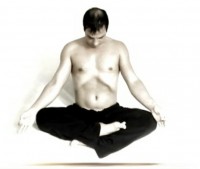Meditation Breathing The following meditation technique draws concepts from ancient Yoga Sutras introduced by Patanjali. The 3 verses below mention the benefits of practicing pranayama. These are ancient breathing exercises. ![]()
Breath becomes stable, rhythmic and natural.
Sutra Chapter 2 verse 51 ![]()
Then the veil which covers the light is destroyed.
Sutra Chapter 2 verse 52 ![]()
The mind becomes capable of concentration.
Sutra Chapter 2 verse 36 ![]()
After exhalation, during the stillness before inhalation,
there is calmness. This can remove distractions.
Yoga Sutra 1-34
"In deep meditation the breathing should be so passive that a small feather could be held under the nose and be unmoved by the air".
Preparation
Find a comfortable seated position that does not stress the joints. This will allow the body to remain stable without pain and discomfort, a major distraction in meditation. ![]()
Spend at least 5 minutes doing relaxing breathing techniques such as humming or Aums. These breathing techniques naturally lengthen the exhalations and have a soothing affect on the nervous system. This will help to maintain stable rhythmic breathing throughout the meditation. ![]()
The Element of Air and Emptying the Mind
1. The element of air can be used to remove thought. When thought is removed the practitioner dwells within a state of true self. ![]()
2. During inhalation visualize the air passing through the mind. This instantly empties the mind and creates a feeling of hollowness within the skull, the clouds of thought vanish. Use of this element (air) in visualization, especially during the inhalations. ![]()
3. The air is one of the methods of breaking down thought and remaining in a state of know true self. When knowledge of true self are gained attachments fall away the practitioner even looses fear of death. When the knowledge is not reinforced it is lost and attachments return. ![]()
4. During meditation the breath is quite often effected by sensations and experiences from rising and changing mind patterns. The breathing becomes irregular and effects the mind. This is a spiral effect of distractions. Be attentive and have a spiritual fire burning from within holding focus steady. ![]()
Pranayama
1. Yoga breathing exercises (pranayama) can be helpful in meditation but they can also be a obstacle. Stability in breath results from the practice of proper breathing exercises. Natural wholesome breaths occur after practice if breathing exercises are performed correctly and for an sufficient length of time. ![]()
2. Pranayama teaches the practitioner the art of concentration. When concentration is maintained it becomes meditation. These skills are necessary because when a state of yoga is attained concentration allows the practitioner to remain in this state of awareness. ![]()
3. In many of the breathing techniques the air is restricted to lengthen the breath. This can cause an individual to subconsciously restrict the air during meditation. Internal conflict will be present as a result of this. Relax all of the nerves during meditation and breath without obstruction. ![]()
4. Yoga breathing techniques have always played an important role in the spiritual arts. They have quite often been done with visualization to balance the energy body. ![]()
5. After training the breath for long periods of time a smooth and harmonious breath also manifests in our meditation practice. It is a pleasant benefit or side effect from Pranayama.


